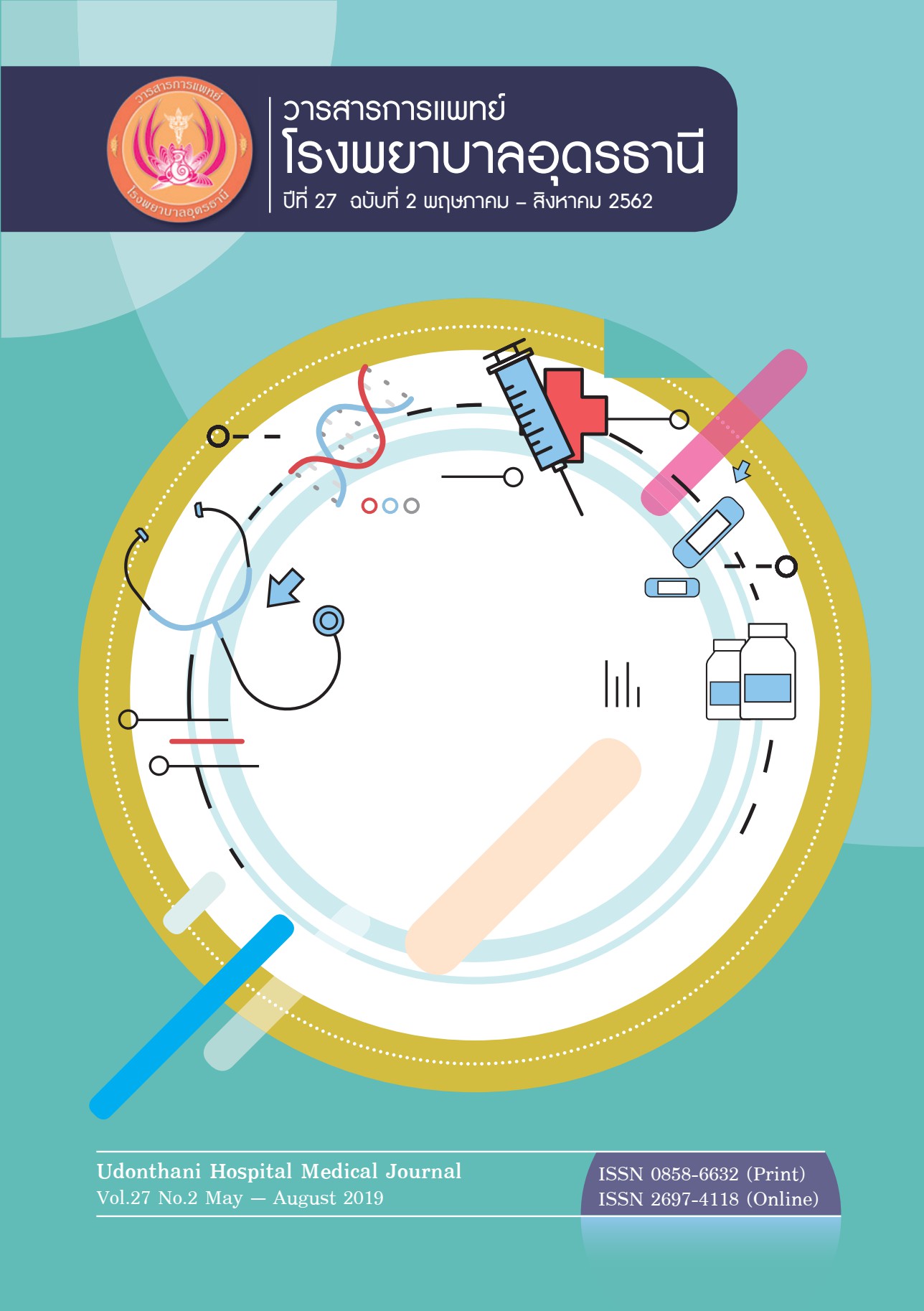ผลของการใช้ระบบ Modified Early Warning Scores (MEWS) ในการรักษาผู้ป่วยที่มีภาวะติดเชื้อในกระแสโลหิต (Sepsis) ที่หอผู้ป่วยในโรงพยาบาลบ้านผือ
คำสำคัญ:
แนวปฏิบัติการดูแลผู้ป่วย, ภาวะติดเชื้อในกระแสโลหิตบทคัดย่อ
การวิจัยนี้เป็นการศึกษาข้อมูลแบบเชิงพรรณามีวัตถุประสงค์เพื่อศึกษาผลลัพธ์ของการใช้แนวปฏิบัติการดูแลผู้ป่วยที่มีภาวะติดเชื้อในกระแสโลหิต (Sepsis)โดยใช้ระบบ Modified Early Warning Score (MEWS) เป็นเครื่องมือที่ประเมินจากอาการและอาการแสดงของผู้ป่วยจากการเปลี่ยนแปลงอวัยวะที่สำคัญมาใช้ในการดูแลผู้ป่วยที่มีภาวะติดเชื้อในกระแสโลหิต (Sepsis) ที่หอผู้ป่วยในโรงพยาบาลบ้านผือ เพื่อช่วยในการเร่งวินิจฉัยให้ได้เร็วที่สุด (Early recognition) ส่งผลให้ผู้ป่วยได้รับการรักษาอย่างทันท่วงทีและเหมาะสมเพื่อลดอัตราการเกิดภาวะติดเชื้อในกระแสโลหิตอย่างรุนแรงและภาวะช็อก (Severe sepsis/Septic shock)และลดอัตราการตายจากภาวะติดเชื้อในกระแสโลหิต (Sepsis) กลุ่มตัวอย่าง คือกลุ่มผู้ป่วยที่ได้รับการวินิจฉัยภาวะติดเชื้อในกระแสโลหิต (Sepsis) ที่เข้ารับการรักษาที่โรงพยาบาลบ้านผือ จำนวนทั้งหมด197 ราย เก็บข้อมูลตั้งแต่ 1 สิงหาคม 2561 – 31 มกราคม 2562 และกลุ่มควบคุมจำนวน 203 ราย วิเคราะห์ข้อมูลโดยใช้สถิติเชิงพรรณนาและสถิติทดสอบเพียร์สันไคสแควร (Pearson Chi-Sq quare)
การวิจัยครั้งนี้พบว่าหลังใช้แนวปฏิบัติการดูแลผู้ป่วยที่มีภาวะติดเชื้อในกระแสโลหิต (Sepsis) โดยใช้ระบบ Modified Early Warning Scores (MEWS) เปรียบเทียบอัตราการเกิด Severe sepsis/Septic shock และอัตรา การตายของภาวะ Sepsis ก่อนและหลังการใช้ระบบ Modified Early Warning Scores (MEWS) พบว่าการวินิจฉัยส่วนใหญ่เป็น Septic shock คิดเป็นร้อยละ 58.62 และ 54.31 ตามลำดับ ไม่มีความแตกต่างกันอย่างมีนัยสำคัญทางสถิติ (p<0.38, 95% CI 0.79- 1.80) และอัตราผู้ป่วยเสียชีวิตร้อยละ 14.78 และ 12.69 ตามลำดับซึ่งไม่มีความแตกต่างกันอย่างมีนัยสำคัญทางสถิติ (p<0.54, 95% CI 0.65-2.21)
เอกสารอ้างอิง
Tools for Early Identification of at-Risk Patients and Treatment Protocol Implementation. Crit Care Clin2008;23: 1–47.
2. Ministry of Public Health. Health Statistics. [Serial on the Internet]. [Cited 2014
Feb12]. Available from: www.moph.go.th
3. Lundberg JS, Perl TM, Wiblin T, Costigan MD, Dawson J, Nettleman MD, et al.
Septic shock: ananalysis of outcomes for patients with onset on hospital wards versus intensive care units. Critical Care Medicine 1998;26: 1020-1024.
4. Martin GS, Mannino DM, Eaton S, Moss M. The Epidemiology of Sepsis in the United
States from 1979 through 2000. New Engl Jounal 2003;348: 1546-54.
5. Rivers E, Nguyen B, Havstad S, Ressler J,Muzzin A, Knoblich B, et al. Early Goal-Directed Therapy in the Treatment of Severe Sepsis and Septic Shock. New Engl Jounal Med 2001; 345:1368–7.
6. Rangel-Frausto S. The Natural History of the Systemic Inflammatory Response Syndrome (SIRS) A Prospective Study. JAMA 1995; 273(2): 117-23.
7. Brun-Buisson C. Incidence Risk Factors and Outcome of Severe Sepsis and Septic Shock in Adults A Multicenter Prospective Study in Intensive Care Units. JAMA 1995; 274(12): 968-74
8. Gao F, Melody T, Daniels DF, Giles S, Fox S. The impact of compliance with 6-hour
and 24-hour sepsis bundles on hospital mortality in patient with severe sepsis-prospective
observational study. Crit Care 2005; 9: R764-70.
9. Kortgen A, Niederprum P, Baucer M. Implementation of an evidence based “standard operating procedure” and outcome in septic shock. Crit Care Med 2006; 34: 943-9.
10. Micek ST, Roubinian N, Heuring T, Bode M, Williams J, Harrison C, et al. Before-after study of a standardized hospital order set for the management of septic shock. Crit Care Med 2006; 34: 2707-13.
11. Otero RM, Nguyen HB, Huang DT, Gaieski DF, Goyal M, Gunnerson KJ, et al. Early
goal-directed therapy in severe sepsis and septic shock revisited. Concepts, controversies, and contemporary findings. Chest 2006; 130: 1579-95.
12. Jones AE, Kline JA. Use of goal-directed therapy for severe sepsis and septic shock in academic emergency department. Crit Care Med 2005; 33: 1888-9.
13. Berwick DM. Disseminating innovations in health care. JAMA 2003; 289:
1969-75.
14. Ho BC, Bellomo R, McGain F, Jones D, Naka T, Wan L, et al. The incidence and
outcome of septic shock patients in the absence of early-goal directed therapy. Crit Care 2006; 10: R80.
15. Dellinger RP, Levy MM, Carlet JM, Parker MM, Jaeschke R, Reinhart K, et al.
Surviving Sepsis Campaign guidelines for management of severe sepsis and septic shock:
2008. Crit Care Med 2008; 36: 296-327.
16. Surviving Sepsis Campaign Bundle 2018. [อินเตอร์เน็ต]. [เข้าถึงเมื่อ 1 กุมภาพันธ์ 2561].
เข้าถึงได้จาก https://link.springer.com/article/10.1007%2Fs00134-018-5085-0
17. ข้อมูลงานเวชระเบียนและสถิติโรงพยาบาลบ้านผือ จำนวนผู้ป่วยโรคติดเชื้อในกระแสโลหิตอย่าง
รุนแรง โรงพยาบาลบ้านผือ อำเภอบ้านผือ จังหวัดอุดรธานี. งานเวชระเบียนและสถิติ โรงพยาบาลบ้านผือ
อำเภอบ้านผือ จังหวัดอุดรธานี; 2559-2561.
18. National Institute for Health and Care Excellence. Sepsis recognition diagnosis and
early management NICE guideline 2016;1-50. nice.org.uk/guidance/ng51
19. Micek ST, Roubinian N, Heuring T, Bode M, Williams J, Harrison C, et al. Before–After Study of a Standardized Hospital Order Set for the Management of Septic Shock. Crit CareMed 2006; 34(11): 2707-13.
ดาวน์โหลด
เผยแพร่แล้ว
รูปแบบการอ้างอิง
ฉบับ
ประเภทบทความ
สัญญาอนุญาต
การละเมิดลิขสิทธิ์ถือเป็นความรับผิดชอบของผู้ส่งบทความโดยตรง
ผลงานที่ได้รับการตีพิมพ์ถือเป็นลิขสิทธิ์ของผู้นิพนธ์ ขอสงวนสิทธิ์มิให้นำเนื้อหา ทัศนะ หรือข้อคิดเห็นใด ๆ ของบทความในวารสารไปเผยแพร่ทางการค้าก่อนได้รับอนุญาตจากกองบรรณาธิการ อย่างเป็นลายลักษณ์อักษร



